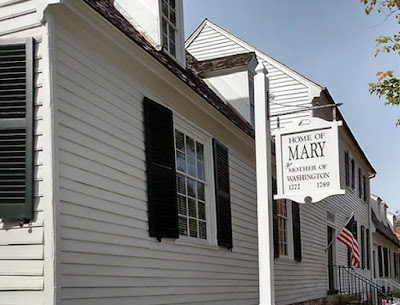Young Mary's father Joseph Ball (1649-1711) died when she was a small child, leaving her the bed furnishings that her mother again willed to her."Item. I give and bequeath unto my said Daughter Mary Ball sufficient furniture for the bed her father Joseph Ball left her, vizt: One suit of good curtains and fallens [valence?], one Rugg, one Quilt, one pair Blankets."
This early-18th-century quilt, although not described, was not patchwork but more likely a whole cloth quilt of silk, wool or perhaps cotton. It may be the same quilt that Mary Ball Washington left in her own 1788 will written the year before she died.
"I give to my son, General George Washington....my best bed, bedstead, and Virginia cloth curtains (the same that stand in my best bedroom), my quilted blue-and white quilt, and my best dressing glass."
We assume that the description blue-and white means a whole cloth bedcover of an indigo cotton print, a popular luxury item. Was it the quilt Mary had owned since her father died nearly 80 years ago? More likely a later quilt from the years when Indian indigoes were more common in the colonies.
George apparently did not pick up the blue and white quilt (he was a busy man.) Younger sister Betty Washington Lewis wrote him a letter the year after Mary's death reminding him of "several articles in my possession, that was left to you by my Mother which has never been sent for."
Perhaps the quilt was among these "mementos of parental affection," as George called them. If he did not want the heirlooms Betty would be glad to keep them herself. "They can be of little or no service to you, and of very great to me, I will thank you for them...."
We don't know what that blue and white quilt looked like, but a couple of the Washington museums include a reproduction in the bedrooms.
"We were lucky enough to locate a blue and white printed cotton, reproduced from a mid-18th century French pattern by Chelsea Textiles in New York. The original version was block printed, but also used wax or paste in the resist method. The result was a detailed repeated floral pattern that also had the rounded edges of resist dying. It was perfect for our uses. The fabric was quilted onto filler and backing, and the entire quilt was cut in a T-shape, to fit around the bedposts of the Washington “best bed”, creating a fitted look which was also typical of the time. Visitors to the Washington house can now see Mary’s favorite blues on display in her bedchamber."










Very interesting. My husband's family is related through the Montagues.
ReplyDelete